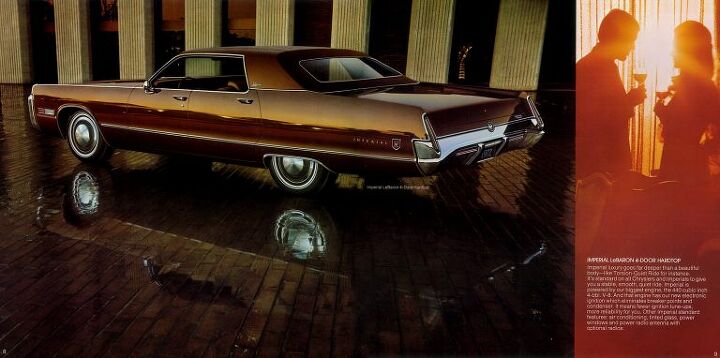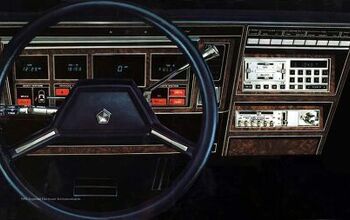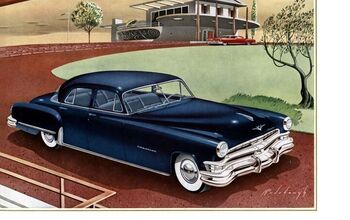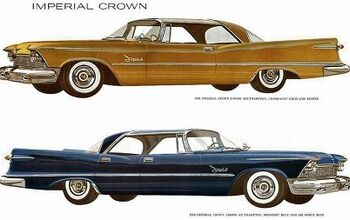Rare Rides Icons: The History of Imperial, More Than Just a Car (Part XIV)

In our last installment of the Imperial saga, we worked through the earliest years of Chrysler’s Fuselage Look era. The Imperial wore its hefty new styling well, even though it shared more parts and even body panels with Chrysler’s lesser New Yorker. Although the new looks were a sales hit in 1969, customers who wanted a Fuselage Imperial bought one immediately. By 1971 things were much grimmer. Imperial was relegated for the first time to a singular trim: LeBaron. A sign of the times, the brand was no longer advertised separately in marketing materials, but alongside Chrysler’s other offerings as “Imperial by Chrysler.” However, for 1972 it was time for a big update, as Chrysler tried to bump up the Imperial’s seriously sagging sales.
The top brass at Chrysler thought the original 1969 iteration of the Fuselage Look didn’t quite say long, low, and heavy properly, so for 1972 Elwood Engel reworked the Imperial entirely. With all-new metal, the ’72 was meant to look larger and more substantial than before, as the flagship evolved into Fuselage 2.0. That year, the series changed from GY (M) to HY (M), as a singular trim remained the only offering.
https://www.web.imperialclub.info/Yr/1972/AnnoucementFilm/72AnChrImp.mp4Visually the Imperial wore a striking resemblance to its predecessor, as intended. At the front end, creases down either side of the fenders became much more pronounced, and the car grew fins at the front. New chrome strips appeared along the fender, much like the ’64 Imperial. While the upper part of the grille still came to a point and was largely unchanged, the lower section was slimmer and had body-colored metal underneath it instead of the full chrome covering of 1971.
At either corner, front battering rams were more pronounced than ever, and included heavier-looking chrome bumper inserts as part of the front clip. Cornering lamps moved upward in the fender, aligned with the top of the tire. The simple rectangular shape of the lamp grew wider and separated into two thinner bars with an angled edge that followed the wheel well.
Front parking lamps were now much larger, dagger-shaped, and pointed forward. The egg-crate grille remained with minor alterations, as horizontally-oriented rectangles shrunk, and became vertically oriented. Once again headlamp doors were integrated into the grille for a smoother look, as the prior year’s opaque plastic adornments vanished. The block Imperial script along the hood of the ’71 was reverted once more into an imperial eagle logo for 1972. Block lettering appeared on the driver’s side corner of the grille, though the lettering was smaller than one might’ve reasonably expected.
Along the side profile, the new edge of the fenders absorbed other sheet metal detailing from the year before: The subtle character line that ran along the fender and under the door handles vanished. Imperial’s side profile was as smooth and boaty as possible. Chrome bodyside trim remained relatively unchanged and was in an almost identical position to before.
At the rear, the full-height chrome spears at the corners present since 1967 disappeared, and in their place, a more conventional-looking bumper appeared. Tail lamps switched positions from their prior horizontal segmented bar and became separate vertical units where the spears used to be. The look was sort of like a slightly shorter take on the Cadillac lamp. The bumper had its own upswept style, with chrome that arced in the middle and flowed back down at either side. The center contained two slim reflectors.
Imperial block lettering remained on the rear fender but moved further forward to make room for a red marker lamp that contained the Imperial eagle logo. A bare trunk lock was now visible, as the Imperial logo migrated lower between the bumper and the lower edge of the body metal. The eagle logo at the rear was surrounded by a sort of crest, made of rather ugly chain detailing.
Though Imperial wore styling intended to make it look heavier and longer, it was in fact a bit shorter than before. The 1972 spanned 229.5 inches, slightly less than the 229.7 of 1971. Width increased as Imperial headed toward a Wide-Trac look, from 79.1 inches to 79.6″ in 1972. Overall height changed very slightly, down to 56 inches even from 56.1 in 1971. Engineering changes did not accompany the restyling, and the same familiar 440 cubic-inch (7.2L) Wedge V8 was shifted along by the A727 TorqueFlite three-speed.
Body styles remained the same in 1972, as the Imperial LeBaron was sold only as two- or four-door hardtop. The four-door asked $6,762 ($45,870 adj.), and the coupe was a bit cheaper at $6,534 ($44,323 adj.). With inflation included, the Imperial’s price increased by about 4 percent in 1972. Absent from marketing materials was the Limousine, as Chrysler no longer contracted with Stageway to build the exclusive eight-passenger. It was a logical business decision, as the 1971 Stageway sold exactly one example. Two limousines were still made in 1972, as the Secret Service ordered a couple for the Nixon Administration.
For their official duties, two black-on-black Imperial sedans were thoroughly reworked by coachbuilder Hess and Eisenhardt (now part of Centigon Security Group). H&E turned the sedans into armored limos for the traveling duties of President Nixon. Both cars remained in state use for some time and were notably selected for Reagan’s swearing-in ceremony in 1981. Aside from the Secret Service, customers also noticed the more serious-looking ’72 Imperial. Sales increased notably to 15,976, from 11,569 in 1971. The distribution of four- to two-door sales remained about the same, as 13,472 sedans were sold, and only 2,322 coupes.
The following year was the last for the independent Imperial’s fourth-generation (the 10th Imperial overall). The most notable change this year was the government hammer that came down in the form of federal bumper regulation. Five miles per hour was the term on everyone’s lips, as cars gained giant bumpers almost nobody wanted.
Like almost all other manufacturers, Chrysler’s new bumpers were compliant with regulation but caused as few changes to sheet metal as possible. The Imperial was getting on in years after all, with its debut back in 1969. Its final year marked the arrival of a new grille, with much smaller segmentation for a mesh look. Other notable visual changes were absent, aside from two rubber bump stops at the front and rear. They served to ruin the smooth chrome look from the prior year. The bumpers had the unintended impact (ha) of increasing Imperial’s overall length, as for only the ’73 model year it was 235.3 inches long, nearly six more than before. Imperial became the longest non-limousine production car since World War II, a record it still holds today.
Series naming changed format this year, as the HY (M) became the 3Y (M). It was the first time an Imperial series started with a number, ending a tradition that dated back to the model’s inception in 1926. Though the new bumpers impressed few outside government offices, sales increased slightly, to 16,729 examples. 1973 was a record year for car sales in the US, 11.4 million in total. That sales peak fell off immediately the following year to 8.8 million, and the US auto market would not match ’73 sales again until 1986.
Falling off was le mot juste at Imperial too, as low-ish sales were predicted to stay that way for some time. Nevertheless Imperial had to continue as the flagship, and there was time for one more C-body. More next time.
[Images: Chrysler]

Interested in lots of cars and their various historical contexts. Started writing articles for TTAC in late 2016, when my first posts were QOTDs. From there I started a few new series like Rare Rides, Buy/Drive/Burn, Abandoned History, and most recently Rare Rides Icons. Operating from a home base in Cincinnati, Ohio, a relative auto journalist dead zone. Many of my articles are prompted by something I'll see on social media that sparks my interest and causes me to research. Finding articles and information from the early days of the internet and beyond that covers the little details lost to time: trim packages, color and wheel choices, interior fabrics. Beyond those, I'm fascinated by automotive industry experiments, both failures and successes. Lately I've taken an interest in AI, and generating "what if" type images for car models long dead. Reincarnating a modern Toyota Paseo, Lincoln Mark IX, or Isuzu Trooper through a text prompt is fun. Fun to post them on Twitter too, and watch people overreact. To that end, the social media I use most is Twitter, @CoreyLewis86. I also contribute pieces for Forbes Wheels and Forbes Home.
More by Corey Lewis
Latest Car Reviews
Read moreLatest Product Reviews
Read moreRecent Comments
- ToolGuy I watched the video. Not sure those are real people.
- ToolGuy "This car does mean a lot to me, so I care more about it going to a good home than I do about the final sale price."• This is exactly what my new vehicle dealership says.
- Redapple2 4 Keys to a Safe, Modern, Prosperous Society1 Cheap Energy2 Meritocracy. The best person gets the job. Regardless.3 Free Speech. Fair and strong press.4 Law and Order. Do a crime. Get punished.One large group is damaging the above 4. The other party holds them as key. You are Iran or Zimbabwe without them.
- Alan Where's Earnest? TX? NM? AR? Must be a new Tesla plant the Earnest plant.
- Alan Change will occur and a sloppy transition to a more environmentally friendly society will occur. There will be plenty of screaming and kicking in the process.I don't know why certain individuals keep on touting that what is put forward will occur. It's all talk and BS, but the transition will occur eventually.This conversation is no different to union demands, does the union always get what they want, or a portion of their demands? Green ideas will be put forward to discuss and debate and an outcome will be had.Hydrogen is the only logical form of renewable energy to power transport in the future. Why? Like oil the materials to manufacture batteries is limited.











































Comments
Join the conversation
I looks to me like Chrysler tried to emulate the classic "Woodlite" headlights from the 30's with the front marker lights. Anyone else see that resemblance? https://www.autoweek.com/car-life/classic-cars/a31473052/woodlites-when-looking-cool-is-more-important-than-seeing-the-road/
I miss the days of cars that actually had individual styling instead of blobs on stilts.